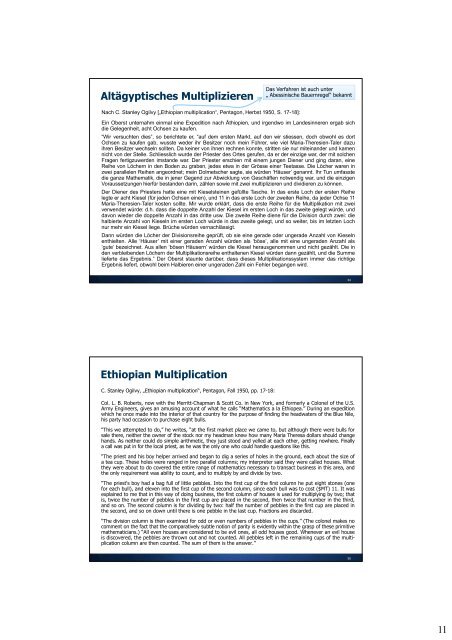2-up - ETH Zürich
2-up - ETH Zürich
2-up - ETH Zürich
Sie wollen auch ein ePaper? Erhöhen Sie die Reichweite Ihrer Titel.
YUMPU macht aus Druck-PDFs automatisch weboptimierte ePaper, die Google liebt.
Altägyptisches Multiplizieren<br />
Das Verfahren ist auch unter<br />
„ Abessinische Bauernregel“ bekannt<br />
Nach C. Stanley Ogilvy [„Ethiopian multiplication“, Pentagon, Herbst 1950, S. 17-18]:<br />
Ein Oberst unternahm einmal eine Expedition nach Äthiopien, und irgendwo im Landesinneren ergab sich<br />
die Gelegenheit, acht Ochsen zu kaufen.<br />
“Wir versuchten dies”, so berichtete er, “auf dem ersten Markt, auf den wir stiessen, doch obwohl es dort<br />
Ochsen zu kaufen gab, wusste weder ihr Besitzer noch mein Führer, wie viel Maria-Theresien-Taler dazu<br />
ihren Besitzer wechseln sollten. Da keiner von ihnen rechnen konnte, stritten sie nur miteinander und kamen<br />
nicht von der Stelle. Schliesslich wurde der Priester des Ortes gerufen, da er der einzige war, der mit solchen<br />
Fragen fertigzuwerden imstande war. Der Priester erschien mit einem jungen Diener und ging daran, eine<br />
Reihe von Löchern in den Boden zu graben, jedes etwa in der Grösse einer Teetasse. Die Löcher waren in<br />
zwei parallelen Reihen angeordnet; mein Dolmetscher sagte, sie würden ‘Häuser’ genannt. Ihr Tun umfasste<br />
die ganze Mathematik, die in jener Gegend zur Abwicklung von Geschäften notwendig war, und die einzigen<br />
Voraussetzungen hierfür bestanden darin, zählen sowie mit zwei multiplizieren und dividieren zu können.<br />
Der Diener des Priesters hatte eine mit Kieselsteinen gefüllte Tasche. In das erste Loch der ersten Reihe<br />
legte er acht Kiesel (für jeden Ochsen einen), und 11 in das erste Loch der zweiten Reihe, da jeder Ochse 11<br />
Maria-Theresien-Taler kosten sollte. Mir wurde erklärt, dass die erste Reihe für die Multiplikation mit zwei<br />
verwendet würde: d.h. dass die doppelte Anzahl der Kiesel im ersten Loch in das zweite gelegt würde, und<br />
davon wieder die doppelte Anzahl in das dritte usw. Die zweite Reihe diene für die Division durch zwei: die<br />
halbierte Anzahl von Kieseln im ersten Loch würde in das zweite gelegt, und so weiter, bis im letzten Loch<br />
nur mehr ein Kiesel liege. Brüche würden vernachlässigt.<br />
Dann würden die Löcher der Divisionsreihe geprüft, ob sie eine gerade oder ungerade Anzahl von Kieseln<br />
enthielten. Alle ‘Häuser’ mit einer geraden Anzahl würden als ‘böse’, alle mit eine ungeraden Anzahl als<br />
‘gute’ bezeichnet. Aus allen ‘bösen Häusern’ würden die Kiesel herausgenommen und nicht gezählt. Die in<br />
den verbleibenden Löchern der Multiplikationsreihe enthaltenen Kiesel würden dann gezählt, und die Summe<br />
lieferte das Ergebnis.” Der Oberst staunte darüber, dass dieses Multiplikationssystem immer das richtige<br />
Ergebnis liefert, obwohl beim Halbieren einer ungeraden Zahl ein Fehler begangen wird.<br />
34<br />
Ethiopian Multiplication<br />
C. Stanley Ogilvy, „Ethiopian multiplication“, Pentagon, Fall 1950, pp. 17-18:<br />
Col. L. B. Roberts, now with the Merritt-Chapman & Scott Co. in New York, and formerly a Colonel of the U.S.<br />
Army Engineers, gives an amusing account of what he calls “Mathematics a la Ethiopea.” During an expedition<br />
whichheoncemadeintotheinteriorofthatcountryforthe purpose of finding the headwaters of the Blue Nile,<br />
his party had occasion to purchase eight bulls.<br />
“This we attempted to do,” he writes, “at the first market place we came to, but although there were bulls for<br />
sale there, neither the owner of the stock nor my headman knew how many Maria Theresa dollars should change<br />
hands. As neither could do simple arithmetic, they just stood and yelled at each other, getting nowhere. Finally<br />
a call was put in for the local priest, as he was the only one who could handle questions like this.<br />
“The priest and his boy helper arrived and began to dig a series of holes in the ground, each about the size of<br />
a tea c<strong>up</strong>. These holes were ranged in two parallel columns; my interpreter said they were called houses. What<br />
they were about to do covered the entire range of mathematics necessary to transact business in this area, and<br />
the only requirement was ability to count, and to multiply by and divide by two.<br />
“The priest's boy had a bag full of little pebbles. Into the first c<strong>up</strong> of the first column he put eight stones (one<br />
for each bull), and eleven into the first c<strong>up</strong> of the second column, since each bull was to cost ($MT) 11. It was<br />
explained to me that in this way of doing business, the first column of houses is used for multiplying by two; that<br />
is, twice the number of pebbles in the first c<strong>up</strong> are placed in the second, then twice that number in the third,<br />
and so on. The second column is for dividing by two: half the number of pebbles in the first c<strong>up</strong> are placed in<br />
the second, and so on down until there is one pebble in the last c<strong>up</strong>. Fractions are discarded.<br />
“The division column is then examined for odd or even numbers of pebbles in the c<strong>up</strong>s.” (The colonel makes no<br />
comment on the fact that the comparatively subtle notion of parity is evidently within the grasp of these primitive<br />
mathematicians.) “All even houses are considered to be evil ones, all odd houses good. Whenever an evil house<br />
is discovered, the pebbles are thrown out and not counted. All pebbles left in the remaining c<strong>up</strong>s of the multiplication<br />
column are then counted. The sum of them is the answer.”<br />
35<br />
11
















